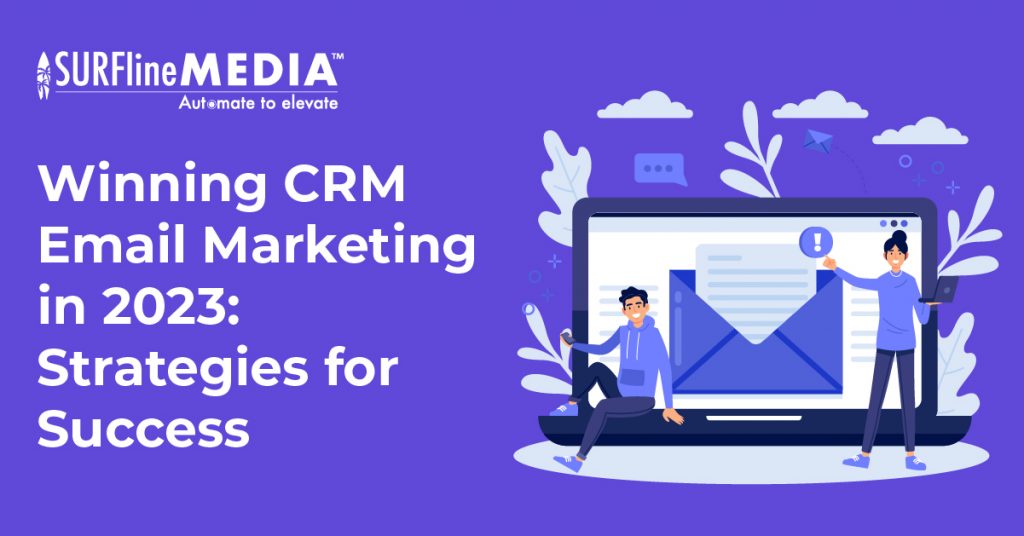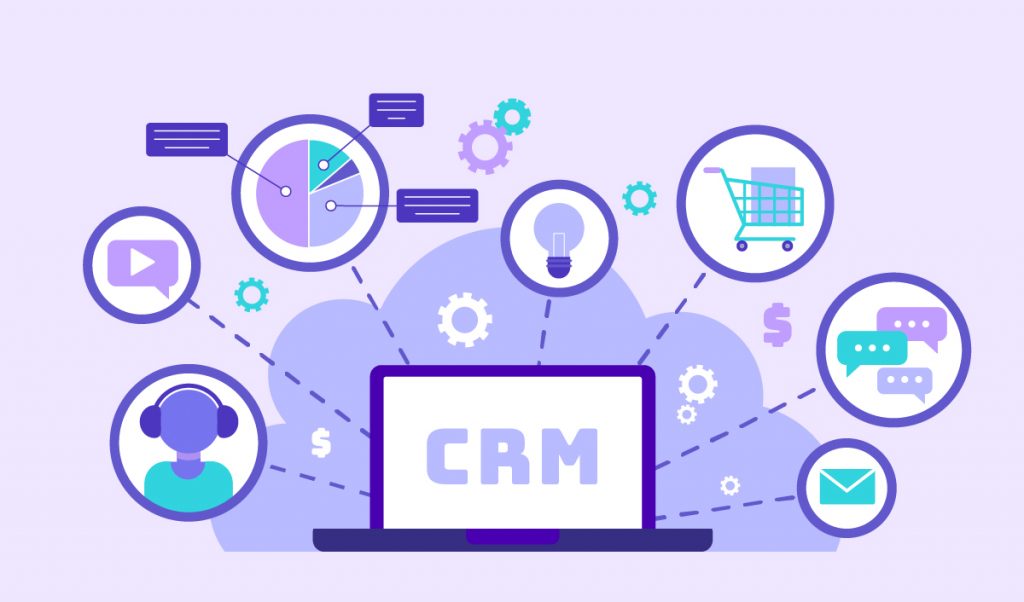

- September 18, 2023
- 4:00 pm
- No Comments
Winning CRM Email Marketing in 2023: Strategies for Success
In today’s fast-paced digital landscape, where competition for customer attention is fierce, effective marketing strategies have become essential for businesses to thrive. One such strategy that has proven to be a game-changer in nurturing customer relationships and driving revenue is CRM email marketing. In this blog, we’ll explore the multifaceted world of CRM email marketing, from setting clear objectives to analyzing key performance metrics, to help businesses harness the full potential of this dynamic marketing approach.
1. Understanding CRM and Email Marketing for Small Businesses
1.1 What is CRM (Customer Relationship Management)?
Customer Relationship Management (CRM) is a strategic approach to managing and enhancing customer relationships. It involves gathering, organizing, and analyzing customer data to understand their needs and preferences, enabling personalized interactions.
Key CRM components include data management, customer interaction tracking, automation, and analytics. Data management ensures accurate customer information, while interaction tracking provides insights into customer journeys. Automation streamlines tasks like email marketing, and analytics guides data-driven decision-making.

Customer Relationship Management (CRM) is a strategic approach to managing and enhancing customer relationships.
In marketing, CRM supports segmentation, personalization, and customer retention. It categorizes customers for targeted campaigns, personalizes messages, and identifies at-risk customers to boost retention. CRM also aids lead management by capturing and tracking leads, streamlining conversion efforts.
1.2 What is Email Marketing?
Email marketing is a digital marketing strategy that involves sending emails to a group of recipients with the goal of promoting products, services, or building relationships with customers. It is a highly effective and versatile tool used by businesses, organizations, and individuals to reach a targeted audience, deliver valuable content, and drive desired actions.

Email marketing is a digital marketing strategy that involves sending emails to a group of recipients.
Email marketing typically includes various types of emails, such as newsletters, promotional emails, transactional emails, and automated email sequences. These emails can be personalized and tailored to specific segments of an email list, ensuring that the content is relevant and engaging for each recipient.
The key components of email marketing include building and maintaining an email list, crafting compelling email content, designing visually appealing templates, tracking email performance through metrics like open rates and click-through rates, and optimizing campaigns based on data-driven insights.
2. The Synergy Between CRM and Email Marketing
2.1 How CRM Enhances Email Marketing
- Personalization and Segmentation
CRM Email Marketing allows businesses to collect and analyze customer data, enabling them to personalize email content based on individual preferences, behaviors, and demographics. This tailored approach increases email relevance and engagement, ultimately improving conversion rates. Additionally, CRM facilitates audience segmentation, allowing marketers to categorize recipients into distinct groups. This segmentation ensures that emails are targeted to specific customer segments, delivering more meaningful and effective messages, and enhancing the overall impact of email marketing with CRM campaigns.
Personalization and segmentation are two crucial aspects in CRM email marketing.
- Data Analytics and Customer Insights
By leveraging CRM systems, businesses can gather valuable data on customer behavior, preferences, and engagement patterns. This data enables marketers to create highly targeted and relevant email campaigns. CRM’s analytics tools provide insights into which emails perform best, helping marketers refine their strategies for improved results. Additionally, CRM Email Marketing allows for the tracking of customer interactions across various touchpoints, providing a holistic view of the customer journey to better understand their customers’ needs and desires.
2.2 Benefits of Integrating CRM with Email Marketing
- Improved Customer Engagement
Crm email marketing integration yields improved customer engagement. CRM systems provide a comprehensive view of each customer, including their preferences and past interactions. This wealth of information enables marketers to create highly personalized and relevant email content that resonates with recipients. When customers receive tailored messages, they are more likely to engage with emails, open them, click through, and ultimately convert. As a result, integrating CRM and email marketing for small businesses leads to stronger customer relationships, higher open and click-through rates, and increased overall engagement.
- Increased Conversion Rates
Crm email marketing integration data helps marketers send targeted and personalized messages, increasing the likelihood of recipients taking desired actions, such as making a purchase or signing up for a service. This heightened relevance and engagement translate into more conversions and improved ROI for email marketing with CRM campaigns.
- Enhanced Customer Retention
Choosing to integrate CRM with email marketing enables businesses to identify at-risk customers and send personalized retention-focused emails. By nurturing existing relationships and addressing customer needs proactively, businesses can reduce churn rates and build long-lasting loyalty, ultimately leading to enhanced customer retention.
3. Building a Quality CRM Email Marketing Database
3.1 Collecting and Storing Customer Data
Collecting and storing customer data is the foundation of a quality CRM Email Marketing database. This process begins by capturing essential information like contact details, purchase history, and communication preferences. It’s crucial to employ ethical and legal practices, ensuring customer consent and data privacy compliance. Storing data in a secure, accessible, and organized manner is equally vital. Cloud-based CRM for email marketing systems are popular for their scalability and data accessibility, allowing businesses to centralize customer information. A well-maintained database ensures accurate and up-to-date records, enabling businesses to deliver personalized and relevant interactions to customers.
3.2 Customer Segmentation for Targeted Campaigns
Customer segmentation is a strategic practice within CRM Email Marketing that involves categorizing customers into distinct groups based on shared characteristics such as demographics, behaviors, or purchase history. This segmentation enables businesses to craft highly targeted email marketing campaigns that resonate with specific customer segments. For example, a clothing retailer can segment customers based on gender and shopping habits, tailoring promotions accordingly.

Customer segmentation is a strategic practice within CRM Email Marketing that involves categorizing customers into distinct groups (source: Angoss).
3.3 Data Cleansing and Quality Assurance
Maintaining data quality is essential for a robust CRM Email Marketing database. Data cleansing involves regularly reviewing and updating customer records to remove duplicates, correct inaccuracies, and fill in missing information. This process ensures that the database remains reliable and accurate. Quality assurance practices involve routine checks to verify data integrity and adherence to data privacy regulations. Automated tools can aid in data validation and verification, helping businesses maintain a high level of data quality.
4. Crafting Effective CRM Email Marketing Campaigns
4.1. Setting Clear Campaign Objectives
Setting clear campaign objectives is the foundational step in crafting effective CRM email marketing campaigns. Businesses must define what they aim to achieve with each email, whether it’s driving sales, increasing website traffic, or nurturing leads. These objectives should be specific, measurable, achievable, relevant, and time-bound (SMART) to ensure they are attainable and trackable. For instance, a SMART objective could be to increase e-commerce sales by 10% through a promotional email campaign within the next two weeks.

These objectives should be specific, measurable, achievable, relevant, and time-bound (SMART) to ensure they are attainable and trackable (source: Internet).
4.2 Creating Compelling Email Content
Content should be engaging, relevant, and valuable to the recipients. Personalization is key; addressing recipients by their names and tailoring content based on their preferences or past interactions can significantly boost engagement. The email’s subject line should be attention-grabbing and provide a glimpse of the content’s value. The body of the email should be concise, scannable, and visually appealing, delivering a clear and compelling message.

Content should be engaging, relevant, and valuable to the recipients (source: Internet).
4.3 Designing Visually Appealing Emails
Visually appealing emails are more likely to capture recipients’ attention and encourage them to engage with the content. The email’s layout should be clean, well-organized, and mobile-responsive to ensure compatibility across various devices. Using high-quality images and graphics that complement the message can enhance the visual appeal. A consistent brand identity with recognizable colors, fonts, and logos helps reinforce brand awareness. Additionally, businesses should consider the placement of key elements like headlines and CTAs, making them prominent and easy to locate.

Visually appealing emails are more likely to capture recipients’ attention and encourage them to engage with the content (source: Internet).
4.4 Incorporating Calls to Action (CTAs)
Calls to action (CTAs) are essential components of CRM email marketing campaigns as they guide recipients towards the desired actions. CTAs should be clear, concise, and action-oriented, prompting recipients to take specific steps such as making a purchase, signing up for a newsletter, or downloading a resource. Effective CTAs use persuasive language, emphasizing the value or benefits of taking action. They should also stand out visually, using contrasting colors or buttons to capture attention. Placing CTAs strategically within the email, both prominently and at the end, ensures that recipients can easily find them.
![Calls-To-Action: Best Practices in Email Marketing [Guide] - Litmus](https://www.litmus.com/wp-content/uploads/2014/12/Primary-CTA.jpg)
Calls to action (CTAs) are essential components of CRM email marketing campaigns as they guide recipients towards the desired actions (source: Litmus).
4.5 Automation and Drip Campaigns
Automation allows businesses to send emails based on triggers or customer behavior, ensuring timely and relevant communication. Drip campaigns involve sending a series of pre-scheduled emails to nurture leads or guide recipients through a specific journey. These campaigns can be highly personalized and tailored to different segments or stages of the customer lifecycle. Automation and drip campaigns save time, increase efficiency, and deliver consistent messaging.
![What is a Drip Campaign and How to Create Them [+Templates]](https://blog.wishpond.com/wp-content/uploads/2022/06/drip-campaign-8.png.webp)
Automation allows businesses to send emails based on triggers or customer behavior, ensuring timely and relevant communication (source: Wishpond Blog).
5. Measuring CRM Email Marketing Performance
Measuring and analyzing CRM email marketing performance is essential to gauge the effectiveness of your campaigns and make data-driven improvements. Key Performance Indicators (KPIs) play a crucial role in this process, providing insights into various aspects of your email marketing automation efforts.
- Open Rate: Measures email open rates, reflecting subject line and sender effectiveness.
- Click-Through Rate (CTR): Indicates engagement by tracking clicks on links or CTAs.
- Conversion Rate: Measures the percentage of recipients taking desired actions after clicking.
- Bounce Rate: Reflects the percentage of undeliverable emails, impacting sender reputation.
- Unsubscribe Rate: Tracks email list attrition; high rates may signal content misalignment.
- Email List Growth Rate: Monitors the pace of email list expansion.
- Return on Investment (ROI): Assesses financial performance by comparing revenue to costs.
- Email Sharing/Forwarding Rate: Measures email content’s shareability and reach extension.
- List Segmentation Performance: Analyzes how distinct list segments engage with emails.
- Spam Complaint Rate: Tracks emails marked as spam, affecting sender reputation.
- Mobile Open Rate: Monitors the percentage of mobile email opens, emphasizing mobile optimization.
6. Conclusion
As we wrap up this exploration of CRM email marketing, it’s clear that this strategy is indispensable for businesses aiming to connect with customers on a deeper level and achieve outstanding marketing results.
Surfline Media is here to offer our expertise and cutting-edge CRM Email Marketing services to help businesses realize your marketing goals. Don’t miss the opportunity to leverage this transformative marketing approach. Contact Surfline Media today!
_______________________

Surfline Media – Automate to Elevate
Our website: https://surflinemedia.com/
Contact us: https://surflinemedia.com/contact-us/
Phone number: +1 323-741-4482
Email: [email protected]






